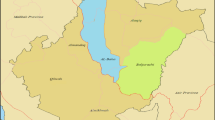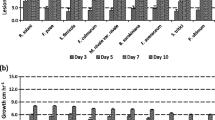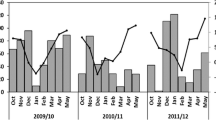Summary
Information on the occurrence and pathogenicity of the fungal mycoflora on Jatropha curcas in Nigeria is scarce, and the present study focused on this issue in Southwestern Nigeria. A survey and randomized fungal sample collection were conducted in six Southwestern states (Ekiti, Lagos, Ogun, Ondo, Osun and Oyo) of Nigeria within different Jatropha curcas fields. Observed disease symptoms were recorded and diseased samples were collected for fungal isolation and identification. Pathogenicity tests of the isolated organisms were carried out on 4-week-old J. curcas seedlings using a foliar spray inoculation technique. Data on percentage occurrence of fungal isolates per state were collected and analysed using analysis of variance and mean separation techniques in SAS. Eleven fungal genera were observed to be associated with Jatropha curcas in Southwestern Nigeria. The occurrence of these organisms differed significantly (p ≤ 0.05) per state. Five genera (Curvularia, Colletotrichum, Fusarium, Lasiodiplodia, and Oidium) were confirmed as pathogenic on J. curcas. There were significant differences in fungal occurrence across the states for all the fungal genera except for Colletotrichum spp. It was evident that among the six states, Ekiti, Ondo and Oyo had the highest recorded occurrences of all the fungi isolated from J. curcas with the exception of Corynespora, suggesting that the crop is more susceptible to fungal infections in those three states.




Similar content being viewed by others
References
Abrego N, Crosier B, Somervuo P, Ivanova N, Abrahamyan A, Abdi A, Ovaskainen O (2020) Fungal communities decline with urbanization—more in air than in soil. ISME J 14(11):2806–2815
Agrios GN (2005) Plant Pathology [Electronic Resource]. Elsevier, EBL: Burlington
Ali RM, Hamad HA, Abdul Mageed MH, Malash GF (2016) Potential of using green adsorbent for heavy metals removal from aqueous solutions: equilibrium, thermodynamic, kinetic and economic studies. J Ecol Eng 91:317–332
Barnett HL, Hunter BB (2001) Illustrated Genera of Imperfect Fungi, 5th edn. MacMillan Publishing Company, New York, p 166
Benge M (2006) Assessment of the potential of Jatropha curcas, (biodiesel tree) for energy production and other uses in developing countries. Posted on ECHO’s website with permission of the author. July 2006 and updated August 2006
Braun U, Cook RTA (2012) Taxonomic Manual of the Erysiphales (Powdery Mildews). In: CBS Biodiversity Series No 11. CBS, Utrecht
Can O (2014) Performance and exhaust emissions of a diesel engine fuelled with a waste cooking oil biodiesel mixture. Energy Convers Manag 87:676–686
Cardoso JE, Vidal JC, Dos Santos AA, Freir FCO, Viana FMP (2002) First report of black branch dieback of cashew caused by Lasiodiplodia theobromae in Brazil. Plant Dis 86:558
Dale BE, Holtzapple M (2015) The need for biofuels. Chem Eng Prog 111(3):36–40
Datimon BD, Glitho AI, Tamo M, Ameroin K (2013) Perception of Farmers on seed Production Constraints of Jatropha curcas L. (Euphobiaceae). Asian J Appl Sci 6(2):99–106
Dehgan B (1984) Phylogenetic Significance of Interspecific Hybridization in Jatropha (Euphorbiaceae). Syst Bot 9(4):467–478
Dehgan B, Schutzman B (1994) Contributions toward a Monograph of Neotropical Jatropha: Phenetic and Phylogenetic Analyses. Ann Mo Bot Gard 81(2):349–367
Dena AK, Hassan AF, Nevine KA, Ahmed AZ, Rehab MA (2018) Smart utilization of Jatropha (Jatropha curcas Linnaeus) seeds for biodiesel production: Optimization and mechanism. Ind Crops Prod 111:407–413
Elazegui FA, Soriano J, Bandong J, Estorninoi L, Jonson I, Teng PS, Shepard BM, Litsinger JA, Moody K, Hibino H (1990) Methodology used in the IRR1 integrated pest survey. In Crop Loss Assessment in Rice pp. 241–271
FAO (2008) The state of food and Agriculture, 2008. Biofuels, Prospects, Risks and Opportunities, FAO, Rome, Italy
Ferreira-Pinto MM, Silva MJ, Santos MR (2011) Screening of Jatropha curcas genotypes to anthracnose caused by Colletotrichum gloeosporioides. Commun Agric Appl Biol Sci 76(4):629–634
Freire FCO, Parente GB (2006) As doenças das Jatrofas (Jatropha curcas L. e J. Podagrica Hook.) no estado do Ceará. C. omunicado Técnico. Embrapa 4(7):115–117
Guan Q, Li Y, Chen Y, Shi Y, Gu J, Li B, Miao R, Chen Q, Ning P (2017) Sulfonated multi-walled carbon nanotubes for biodiesel production through triglycerides trans-esterification. RSC Adv 7:7250–7258
Hanski I, Hertzen L, Fyhrquist N, Koskinen K, Torppa K, Laatikainen T, Karisola P, Auvinen P, Paulin L, Mäkelä MJ, Vartiainen E, Kosunen TU, Alenius H, Haahtela T (2012) Proc Natl Acad Sci USA 109(21):8334–8339
Heller J (1996) Physic nut. Jatropha curcas L. Promoting the conservation and use of underutilized and neglected crops. Institute of plant Genetics and Crop Plant Research, Gatersleben/ International Plant Genetic Resources Institute, Rome. ISBN 92–9043–278–0
Hoek TA, Axelrod K, Biancalani T, Yurtsev EA, Liu J, Gore J (2016) Resource availability modulates the cooperative and competitive nature of a microbial cross-feeding mutualism. PLoS Biol 14(8):e1002540
Hull R (2014) Plant Virology. Academic Press, Burlington, NJ
Islam AK, Yaakob Z, Anuar N (2011) Jatropha: A multipurpose plant with considerable potential for the tropics. Sci Res Essays 6(13):2597–2605
Kamel DA, Farag HA, Amin NK, Fouad YO (2016) Biodiesel synthesis from non-edible oils by transesterification using the activated carbon as heterogeneous catalyst. Int J Environ Sci Technol 14:785–794
Kamel DA, Hassan AF, Nevine KA, Ahmed AZ, Rehab M (2018) Smart utilization of jatropha (Jatropha curcas Linnaeus) seeds for biodiesel production: Optimization and mechanism. Ind Crops Prod 111:407–413
Karavina C, Zivenge E, Mandumbu R, Parwada C (2011) Jatropha curcas Production in Zimbabwe: Uses, Challenges and the Way Forward. Mod Appl Sci 5(2):239–243
Kaushik N, Roy S, Biswas GC (2006) Screening of Indian Jatropha curcas for selection of high oil yielding plants. Indian J For 8:54–57
Khanzada MA, Lodhi AM, Shahzad S (2004) Mango dieback and gummosis in Sindh, Pakistan caused by Lasiodiplodia theobromae. Plant Health Prog 5(1):13
Kozanitas M, Osmundson TW, Linzer R, Garbelotto M (2017) Interspecific interactions between the Sudden Oak Death pathogen Phytophthora ramorum and two sympatric Phytophthora species in varying ecological conditions. Fungal Ecol 28:86–96
Kumar A, Sharma S (2008) An Evaluation of Multipurpose oil Seed crop for Industrial uses (Jatropha curcas L.): A review. Ind Crops Prod 28(1):1–10
Kuzdraliński A, Szczerba H, Tofil K, Filipiak A, Garbarczyk E, Dziadko P, Solarska E (2014) Early PCR-based detection of Fusarium culmorum, F. graminearum, F. sporotrichioides and F. poae on stem bases of winter wheat throughout Poland. Eur J Plant Pathol 140(3):491–502
Leslie JF, Summerell BA (2006) The Fusarium Laboratory Manual, Blackwell Publishing. pp.388
Millennium Ecosystem Assessment (2005) Synthesis report. Island, Washington, DC
Machado AR, Pereira OL (2012) Major diseases of the biofuel plant, Physic nut (Jatropha curcas). Biodiesel: Feedstocks. Production and Applications
Mohali S, Burgess TI, Wingfield MJ (2005) Diversity and host association of the tropical tree endophyte Lasiodiplodia theobromae revealed using simple sequence repeat markers. Forest Pathol 35:385–396
Niemelä J, Breuste J, Guntenspergen G, McIntyre N, Elmqvist T (2011) Urban Ecology: Patterns, Processes, and Applications. Oxford University Press, New York, USA
O’Donnell K, Ward TJ, Aberra D, Kistler HC, Aoki T, Orwig N et al (2008) Multilocus genotyping and molecular phylogenetics resolve a novel head blight pathogen within the Fusarium graminearum species complex from Ethiopia. Fung Genet Biol 45:1514–1522
Philips AJ, Alves A, Penncook SR, Johnston PR, Ramaley A, Akulo APW (2008) A new record of Pestalotiopsis versicolor on the leaves of Jatropha curcas. Indian Phytopathol 28:546. ISSN: 0367–973X
Plant-disease-online (2020) A Gardener’s Guide to Plant Diseases. Accessed (www.envii.co.uk/garden-blog-post/plant-disease-guide/) 16th April, 2020
Prasad DMR, Izam A, Khan MR (2012) Jatropha curcas: Plant of medical benefits. J Med Plant Res 6(14):2691–2699
Qian J, Shi H, Yun Z (2010) Preparation of biodiesel from Jatropha curcas L. oil producedby two-phase solvent extraction. Biores Technol 101:7025–7031
Reddy A. N. R., Saleh, A. A., Islam, M. S., Hamdan, S., (2017) Active razor shell CaO catalystsynthesis for jatropha methyl ester production via optimized two-step transesterification. J Chem 1–20
Sá DAC, Santos GRS, Furtado GQ, Erasmo EAL, Nascimento IR (2011) Transporte, patogenicidade e transmissibilidade de fungos associados às sementes de pinhão manso. Revista Brasileira De Sementes 33(4):663–670
Sarver BA, Ward TJ, Gale LR, Broz K, Kistler HC, Aoki T, O’Donnell K (2011) Novel Fusarium head blight pathogens from Nepal and Louisiana revealed by multilocus genealogical concordance. Fungal Genet Biol 48(12):1096–1107
STAR, version 2.0. 1 (2014) Biometrics and Breeding Informatics
Slippers B, Burgess T, Wingfield BD, Crous PW, Coutinho TA, Wingfield MJ (2004) Development of SSR markers for Botryosphaeria spp. with Fusicoccum anamorphs. Mol Ecol Notes 4:675–677
Stephen HB (2012) The Institute of Food and Agricultural Science (IFAS) Lee Count Extension, Fort Myers, Florida, http://lee.ifas.ufl.edu/hort/GardenHome.shtml
Tollenaere C, Lacombe S, Wonni I, Barro M, Ndougonna C, Gnacko F, Brugidou C (2017) Virus-bacteria rice co-infection in Africa: field estimation, reciprocal effects, molecular mechanisms, and evolutionary implications. Front Plant Sci 8:645
Weir BS, Johnston PR, Damm U (2012) The Colletotrichum gloeosporioides species complex. Stud Mycol 73:115–180
Yli-Matti T, Gagkaeva T, Ward TJ, Aoki T, Kistler HC, O’Donnell K (2009) A novel Asian clade within the Fusarium graminearum species complex includes a newly discovered cereal head blight pathogen from the Far East of Russia. Mycologia 101:841–852
Acknowledgements
Authors would like to thank the Forestry Research Institute of Nigeria (FRIN) and the University of Ibadan, Nigeria for all the facilities provided during this work.
Author information
Authors and Affiliations
Ethics declarations
Conflict of Interest
The authors declare that they have no potential conflict of interest in relation to the study in this paper.
Ethical clearance
Manuscript does not contain any results of experimental studies on human participants and animal.
Additional information
Publisher's Note
Springer Nature remains neutral with regard to jurisdictional claims in published maps and institutional affiliations.
Rights and permissions
About this article
Cite this article
Nwogwugwu, J.O., Adewale, D.B., Batcho, A.A. et al. Occurrence and pathogenicity of fungal genera on Jatropha curcas L. in Southwestern Nigeria. J Plant Pathol 104, 295–303 (2022). https://doi.org/10.1007/s42161-021-01014-w
Received:
Accepted:
Published:
Issue Date:
DOI: https://doi.org/10.1007/s42161-021-01014-w




